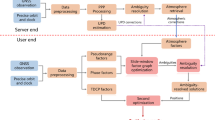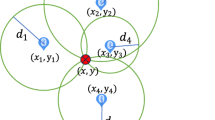Abstract
Now indoor fingerprint maps are mostly generated and maintained by professional companies, where the generation efficiency and update frequency are relatively slow. To address such issues, the paper devises a crowdsourcing method, which uses the sensed data from personal smart devices to build a Wi-Fi fingerprint based map for indoor navigation. Our method uses the positions with high centrality as landmarks. Moreover, based on the improved Euclidean Distance method and Access Points (APs) rank, we devise a Coefficient Weighting algorithm to match the Wi-Fi fingerprints among the Wi-Fi Received Signal Strength (RSS) sequences, which also applied together with a scoring matrix to decrease the redundant data brought by trajectories overlapping. The experimental results show that: (1) our proposed method not only reducing the redundant data brought by crowdsourcing, but also updating the map in a near-real-time manner; (2) the mean positioning error of the generated map is \(< 2\) m, which obviously outperforms the known methods such as LiFs, CALL, etc.








Similar content being viewed by others
References
Want, R., Hopper, A., Falcao, V., & Gibbons, J. (1992). The active badge location system. ACM Transactions on Information Systems, 10(1), 91–102.
Harter, A., Hopper, A., Steggles, P., Ward, A., & Webster, P. (2002). The anatomy of a context-aware application. Wireless Networks, 8(2), 187–197.
Balakrishnan, H., Priyantha, N. B., & Chakraborty, A. (2000). The cricket location-support system. Proceding of ACM MobiCom, 8, 32–43.
Madhavapeddy, A., & Tse, A. (2005). A study of bluetooth propagation using accurate indoor location mapping. In: Beigl, M., Stephen, I., Jun, R., & Hideyuki, T. (eds.) UbiComp 2005: ubiquitous computing (pp. 105–122). Springer.
Gwon, Y., & Jain, R. (2004). Error characteristics and calibration-free techniques for wireless LAN-based location estimation. In Proceedings of the second international workshop on Mobility management & wireless access protocols (pp. 2–9).
Lim, H., Kung, L. C., Hou, J. C., & Luo, H. (2010). Zero-configuration indoor localization over IEEE 802.11 wireless infrastructure. Wireless Networks, 16(2), 405–420.
Chintalapudi, K., Padmanabha Iyer, A., & Padmanabhan, V. N. (2010, September). Indoor localization without the pain. In Proceedings of the sixteenth annual international conference on Mobile computing and networking (pp. 173–184).
Bahl, P., & Padmanabhan, V. N. (2000). Radar: An in-building rf-based user location and tracking system. In Proceedings IEEE INFOCOM 2000. Conference on computer communications. 19th annual joint conference of the IEEE computer and communications societies (Cat. No. 00CH37064) (Vol. 2, pp. 775–784).
Youssef, M., & Agrawala, A. (2008). The Horus location determination system. Wireless Networks, 14(3), 357–374.
Azizyan, M., Constandache, I., & Roy Choudhury, R. (2009). Surround-sense: Mobile phone localization via ambience fingerprinting. In Proceedings of the 15th annual international conference on mobile computing and networking, MOBICOM 2009, Beijing, China, September 20–25, 2009.
Wang, J., Xiao, Y., & Zhang, S. (2017). An indoor localization algorithm based on multidimensional scaling and region refinement. Chinese Journal of Computers, 8, 196–210 (in Chinese).
Luo, H., Zhao, F., Jiang, M., Ma, H., & Zhang, Y. (2017). Constructing an indoor floor plan using crowdsourcing based on magnetic fingerprinting. Sensors, 17(11), 2678.
Feng, J., Feng, J., & Li, G. (2015). A survey on crowdsourcing. Chinese Journal of Computers, 9, 1713–1726 (in Chinese).
Wu, C., Yang, Z., Liu, Y., & Xi, W. (2013). Will: Wireless indoor localization without site survey. IEEE Transactions on Parallel and Distributed Systems, 24(4), 839–848.
Chen, Q., & Wang, B. (2015). Finccm: Fingerprint crowdsourcing, clustering and matching for indoor subarea localization. IEEE Wireless Communications Letters, 4(6), 677–680.
Yang, S., Dessai, P., Verma, M., & Gerla, M. (2013). Freeloc: Calibration-free crowdsourced indoor localization. In 2013 Proceedings IEEE INFOCOM (pp. 2481–2489).
Zhou, M., Wong, A. K., Tian, Z., Luo, X., Xu, K., & Shi, R. (2014). Personal mobility map construction for crowd-sourced Wi-Fi based indoor mapping. IEEE Communications Letters, 18(8), 1427–1430.
Zou, H., Luo, Y., Lu, X., Jiang, H., & Xie, L. (2015). A mutual information based online access point selection strategy for Wi-Fi indoor localization (pp. 180–185).
Huang, P., Zhao, H., Liu, W., & Jiang, D. (2020). MAPS: Indoor localization algorithm based on multiple AP selection. Mobile Networks and Applications, 7, 649–656.
Abadleh, A., Han, S., Hyun, S. J., Lee, B., & Kim, M. (2016). Construction of indoor floor plan and localization. Wireless Networks, 22(1), 175–191.
Chon, J., & Cha, H. (2011). Lifemap: A smartphone-based context provider for location-based services. IEEE Pervasive Computing, 10(2), 58–67.
Alzantot, M., & Youssef, M. (2012). Crowdinside: automatic construction of indoor floorplans. In Proceedings of the 20th International Conference on Advances in Geographic Information Systems (pp. 99–108).
Liu, K., Cui, H., Xiong, H., &Wang, S. (2018). Path loss model based AP selecting chamber locating method, patent, CN108834047-A.
Wang, H., Sen, S., Elgohary, A., Farid, M., Youssef, M., & Choudhury, R. R. (2012). No need to war-drive: Unsupervised indoor localization. In Proceedings of ACM MobiSystem (pp. 197–210).
Pahlavan, K., & Krishnamurthy, P. (2001). Principles of wireless networks (Vol. 1). Prentice Hall PTR.
Kossack, C., & Kendall, M. (1950). Rank correlation methods. The American Mathematical Monthly, 57, 425.
Tian, Z., Zhang, Y., Zhou, M., & Liu, Y. (2014). Pedestrian dead reckoning for MARG navigation using a smartphone. EURASIP Journal on Advances in Signal Processing, 2014(1), 65.
Acknowledgements
This work was supported in part by National Natural Science Foundation of China under Grants 62072217 and 61672269.
Author information
Authors and Affiliations
Corresponding author
Additional information
Publisher's Note
Springer Nature remains neutral with regard to jurisdictional claims in published maps and institutional affiliations.
Rights and permissions
About this article
Cite this article
Ji, Y., Zhao, X., Wei, Y. et al. Generating indoor Wi-Fi fingerprint map based on crowdsourcing. Wireless Netw 28, 1053–1065 (2022). https://doi.org/10.1007/s11276-022-02898-x
Accepted:
Published:
Issue Date:
DOI: https://doi.org/10.1007/s11276-022-02898-x




